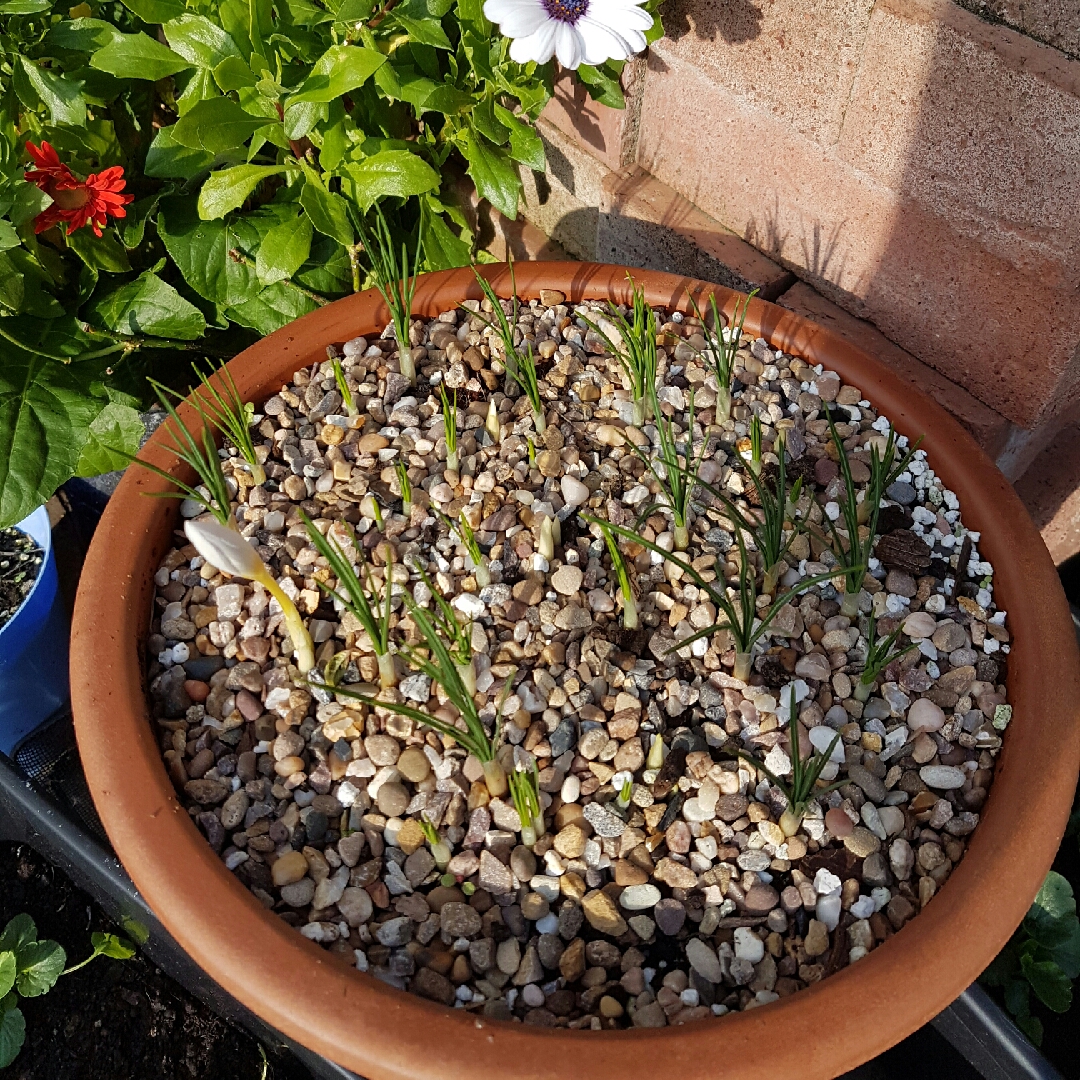
Crocus cartwrightianus 'Albus Tubergen' syn. Crocus sativus 'Albus', Crocus sativus subsp. cartwrightianus 'Albus'
Crocus (Species) Wild Saffron 'Albus'
Crocuses are plants which grow from corms, whose flowers can appear in Autumn, Winter or Spring depending on the species and cultivar. They are typically native to woodlands, scrub and meadows in a variety of conditions across Northern Africa, Middle East, Southern and Central Europe and across to Asia and China. They produce grass like foliage, with a central white stripe, and cup shaped flowers ranging from whites, mauves, lilacs and yellows. In cultivation, autumn crocus see flowers emerge followed by foliage. They are suitable for planting in groups in borders or rock gardens and some species naturalise in grass. Most require a well draining gritty soil and like full sun or dappled shade. In heavier soils, it is worth adding grit to help lighten the soil and improve drainage. Most crocus propagate through production of new corms, however a couple of species do very well naturally via seed. Crocus cartwrightianus is often known as Wild Saffron and it produces lilac flowers in autumn and early winter that have deep red veins and red stigmas. 'Albus Tubergen' is a cultivated white form.
Contributed by @tina
-
Full sun to partial shade
-
Very little water
-
Full Frost Hardy: 5F (-15°C)
-
Light and free draining
Common name
Crocus (Species) Wild Saffron 'Albus'
Latin name
Crocus cartwrightianus 'Albus Tubergen' syn. Crocus sativus 'Albus', Crocus sativus subsp. cartwrightianus 'Albus'
type
Flowering corms
family
Iridaceae
ph
5.0 - 7.0 Acid - Neutral
Plant & bloom calendar
-
Best time to plant
-
When the plant will bloom
full grown dimensions
 0.01 M
0.10 M
0.01 M
0.10 M
Crocus cartwrightianus 'Albus Tubergen' syn. Crocus sativus 'Albus', Crocus sativus subsp. cartwrightianus 'Albus'
Crocuses are plants which grow from corms, whose flowers can appear in Autumn, Winter or Spring depending on the species and cultivar. They are typically native to woodlands, scrub and meadows in a variety of conditions across Northern Africa, Middle East, Southern and Central Europe and across to Asia and China. They produce grass like foliage, with a central white stripe, and cup shaped flowers ranging from whites, mauves, lilacs and yellows. In cultivation, autumn crocus see flowers emerge followed by foliage. They are suitable for planting in groups in borders or rock gardens and some species naturalise in grass. Most require a well draining gritty soil and like full sun or dappled shade. In heavier soils, it is worth adding grit to help lighten the soil and improve drainage. Most crocus propagate through production of new corms, however a couple of species do very well naturally via seed. Crocus cartwrightianus is often known as Wild Saffron and it produces lilac flowers in autumn and early winter that have deep red veins and red stigmas. 'Albus Tubergen' is a cultivated white form.
Planting Season (Late Summer)
From Late Summer TO Early Autumn
Plant autumn crocus corms in late summer for flowering in early autumn. Crocus corms have a flattened base, and slightly pointed top. They should be planted in moist, free-draining soil that has been enriched with organic compost or well-rotted manure, in a sunny, or partially sunny site. Plant the corms before the first frost.
Flowering Season (Autumn)
From Early Autumn TO Late Autumn
Autumn Crocus flowers start to appear as early as late summer, through to late autumn.








